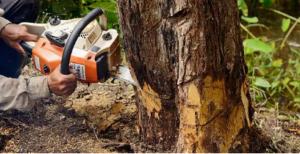Adelaide Hills, with its lush greenery and diverse ecosystems, is a haven for biodiversity in South Australia. However, the delicate balance of this natural landscape can be disrupted by the necessity of tree removal near me. Whether due to safety concerns, urban development, or ecological restoration, the removal of trees must be approached with careful consideration to minimise environmental impact and preserve biodiversity. In this article, we explore sustainable practices for tree removal in Adelaide Hills that prioritise biodiversity conservation while addressing the need for tree management.
Understanding Biodiversity in Adelaide Hills:
 Before delving into sustainable practices for tree removal, it’s essential to understand the biodiversity of Adelaide Hills. This region is characterised by a variety of habitats, including native forests, woodlands, grasslands, and riparian zones. These habitats support a diverse array of flora and fauna, including native trees such as eucalypts, acacias, and she-oaks, as well as iconic wildlife like koalas, kangaroos, and numerous bird species.
Before delving into sustainable practices for tree removal, it’s essential to understand the biodiversity of Adelaide Hills. This region is characterised by a variety of habitats, including native forests, woodlands, grasslands, and riparian zones. These habitats support a diverse array of flora and fauna, including native trees such as eucalypts, acacias, and she-oaks, as well as iconic wildlife like koalas, kangaroos, and numerous bird species.
The Importance of Sustainable Tree Removal:
While trees provide numerous benefits, including carbon sequestration, habitat provision, and soil stabilisation, there are instances where tree removal is necessary. Hazardous trees, invasive species, and land-use changes are some reasons that may warrant tree removal in Adelaide Hills. However, unsustainable tree removal practices can have detrimental effects on biodiversity, including habitat loss, fragmentation, and disruption of ecosystem services.
Sustainable Practices for Tree Removal:
- Prioritise Native Species: When selecting trees for removal, prioritise non-native or invasive species over native ones. Native trees play a vital role in supporting local biodiversity and ecosystem function, making their preservation a priority.
- Selective Removal: Instead of clear-cutting entire areas, opt for selective tree removal near me. Target specific trees that pose safety risks are diseased or damaged beyond repair or obstruct planned development while preserving healthy trees and maintaining habitat diversity.
- Habitat Assessment: Before removing trees, conduct thorough habitat assessments to identify potential impacts on wildlife. Consider factors such as nesting sites, food sources, and wildlife corridors to minimise disturbance to local fauna.
- Tree Replanting and Restoration: Implement tree replanting and habitat restoration initiatives as part of the tree removal process. Replace removed trees with native species that are appropriate for the local ecosystem, promoting habitat connectivity and enhancing biodiversity.
- Avoidance of Sensitive Areas: Exercise caution when removing trees in sensitive habitats such as riparian zones, wetlands, or areas with high species diversity. These areas are often critical for maintaining biodiversity and ecosystem resilience and should be protected from unnecessary disturbance.
- Consultation and Engagement: Engage with local communities, environmental organisations, and Indigenous stakeholders throughout the tree removal process. Seek input on conservation priorities, identify culturally significant trees, and incorporate traditional ecological knowledge into decision-making.
- Monitoring and Adaptive Management: Monitor the ecological impacts of tree removal activities over time and be prepared to adjust management practices as needed. Adaptive management allows for ongoing assessment and refinement of strategies to ensure positive outcomes for biodiversity conservation.
Case Study: Sustainable Tree Removal in Adelaide Hills
To illustrate these sustainable practices in action, let’s consider a hypothetical scenario of tree removal in Adelaide Hills:
In a designated urban development area, several non-native pine trees have been identified for removal to make way for residential construction. Before proceeding with tree removal, a thorough habitat assessment is conducted to identify potential impacts on local wildlife, including bird nesting sites and habitat connectivity. Based on the assessment, only the designated pine trees are removed, while native trees and vegetation are preserved to maintain habitat diversity.
Preserving biodiversity is paramount in the management of tree removal in Adelaide Hills. By adopting sustainable practices that prioritise native species, selective tree removal near me, habitat assessment, and community engagement, stakeholders can mitigate the negative impacts of tree removal while promoting ecosystem health and resilience. Through careful planning, collaboration, and ongoing monitoring, Adelaide Hills can continue to thrive as a vibrant and biodiverse landscape for generations to come.
